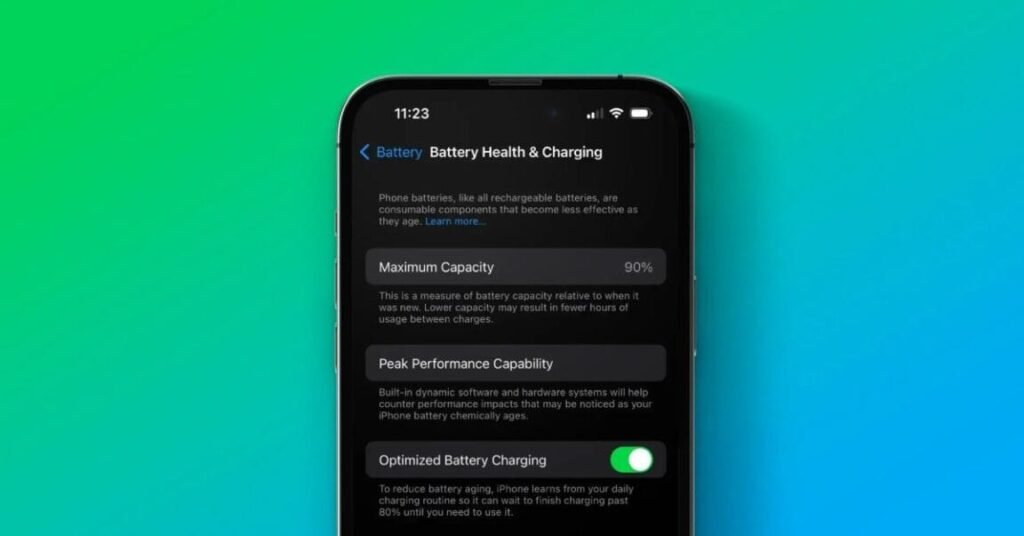1. Understand Battery Health Metrics
○ Check Battery Health: Go to Settings > Battery > Battery Health to view your battery’s maximum capacity and peak performance capability. This will give you an overview of your battery’s overall health.
2. Enable Optimized Battery Charging
○ Turn On Optimization: Go to Settings > Battery > Battery Health and enable Optimized Battery Charging. This feature learns your charging routine and reduces battery aging by delaying charging past 80% until you need to use your iPhone.
3. Avoid Extreme Temperatures
○ Maintain Optimal Temperature: Keep your iPhone in environments with temperatures between 16° and 22°C (62° and 72°F). Extreme heat or cold can negatively impact battery performance and longevity.
4. Reduce Screen Brightness
○ Adjust Brightness: Lower your screen brightness to reduce battery consumption. Go to Settings > Display & Brightness and use the slider to adjust brightness, or enable Auto-Brightness to let your iPhone adjust it automatically based on ambient lighting.
5. Enable Low Power Mode
○ Activate Low Power Mode: When your battery is running low, enable Low Power Mode by going to Settings > Battery and toggling Low Power Mode on. This reduces background activity and optimizes performance to extend battery life.
6. Manage Background App Refresh
○ Control Background Activity: Prevent apps from refreshing content in the background. Go to Settings > General > Background App Refresh and select Off or Wi-Fi to limit background data usage.
7. Turn Off Unnecessary Notifications
○ Minimize Notifications: Limit notifications that wake your screen and use battery power. Go to Settings > Notifications and customize settings for each app to reduce unnecessary alerts.
8. Disable Location Services When Not Needed
○ Manage Location Settings: Limit apps’ access to your location to conserve battery life. Go to Settings > Privacy > Location Services and set the desired apps to While Using the App or Never based on your preferences.
9. Update iOS Regularly
○ Keep iOS Updated: Ensure you’re running the latest version of iOS, which often includes battery performance improvements. Go to Settings > General > Software Update to check for and install updates.
10. Close Unused Apps
○ Manage Open Apps: Close apps running in the background that you are not using. Double-tap the Home button (or swipe up from the bottom of the screen on iPhone X and later) and swipe up on apps you want to close.
11. Turn Off Unnecessary Features
○ Disable Features: Turn off features like Bluetooth and Wi-Fi when not in use. Swipe into Control Center and toggle off these features to save battery life.
12. Use Dark Mode
○ Enable Dark Mode: On OLED screens, Dark Mode can reduce battery usage. Go to Settings > Display & Brightness and select Dark under Appearance.
13. Reduce Motion and Animations
○ Limit Animations: Reduce the motion of user interface elements to save battery. Go to Settings > Accessibility > Motion and toggle on Reduce Motion.
14. Disable Automatic Downloads and Updates
○ Control Downloads: Prevent automatic app updates and downloads that can use battery. Go to Settings > App Store and toggle off App Updates and Automatic Downloads.
15. Monitor Battery Usage by App
○ Review Battery Usage: Check which apps use the most battery by going to Settings > Battery. Review and manage app usage to conserve battery life.
16. Enable Airplane Mode in Low Signal Areas
○ Switch to Airplane Mode: If you’re in an area with poor signal, enable Airplane Mode to prevent your iPhone from constantly searching for a signal. Go to Settings > Airplane Mode and toggle it on.
17. Keep Battery Contacts Clean
○ Maintain Battery Contacts: Ensure that the battery contacts are clean and free of debris to maintain optimal battery performance. Use a soft, dry cloth to clean the contacts if necessary.
18. Avoid Overcharging
○ Charge Wisely: Avoid keeping your iPhone plugged in once it reaches 100%. Unplugging it as soon as it’s fully charged helps reduce battery stress.
19. Use the Right Charger
○ Choose Compatible Chargers: Use Apple-certified chargers and cables to ensure safe and efficient charging. Avoid using third-party chargers that may not meet quality standards.
20. Reset All Settings if Necessary
○ Perform a Reset: If you experience persistent battery issues, you may need to reset all settings. Go to Settings > General > Transfer or Reset iPhone > Reset > Reset All Settings. This won’t delete your data but will reset system settings and preferences.
By implementing these practices, you can maximize your iPhone’s battery health, ensuring longer battery life and optimal performance throughout the day.







